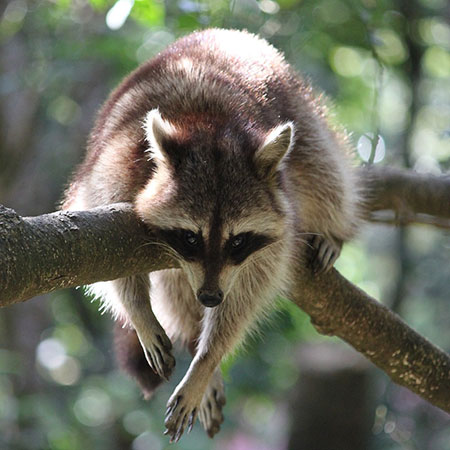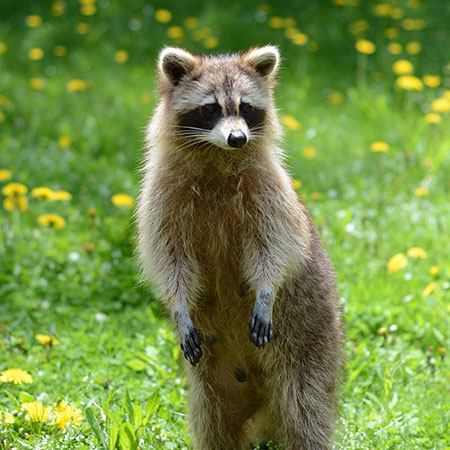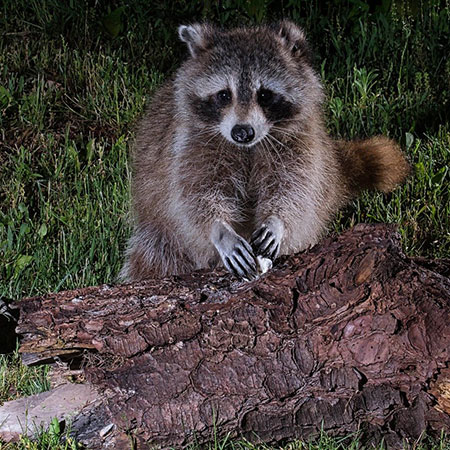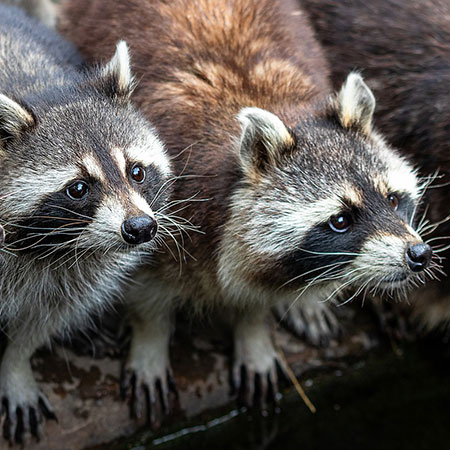General Information
The Raccoon is a mammal that is native to North America. It is the largest of the procyonid family which includes kinkajous and coatis.
Size
The Raccoon weight ranges from 11 – 57 pounds.
Appearance
Raccoon fur is usually a mix of gray, black, and brown. Raccoons have soft, fluffy coas. There are a variety of colorations such as blonde, cinnamon and albino. They are probably best know for their dark mask around their eyes.
Lifespan
The raccoon lives 2-3 years in the wild but can live up to 20 years in captivity.
Habitat
Raccoons can be found in the woods of North America along the riverbanks.
They like to hide inside of tree cavities, fallen logs and burrows. The raccoon was also introduced to other areas of the world and can be found in Canada, Northern South America, Mexico, Germany, Japan and Russia. You will also see them in your neighborhoods often foraging through the trash cans.
Diet
The raccoon is an omnivore and an opportunistic eater. The environment totally influences the raccoon diet They will eat just about anything, fruits, berries, rodents, eggs, ,insects, frogs, crabs, crayfish and they are often found sifting through the trash. Always provide them with fresh water daily.
Reproduction
Females reach sexual maturity at about 1 year old while males reach theirs at about age 2 years. Gestation is about 60-74 days and they can have up to 5 babies known as kits in a litter. Raccoon mating season can be anytime between January and June.
Other facts
They are intelligent, good swimmers, excellent climbers. They communicate with growls, hisses, whistles and snarls. They are nocturnal and are active mostly at night. The front paws are very sensitive giving them a heightened sense of touch.




Basic Care
Feeding
You will want to provide a variety of foods However, a quality dry dog food makes a good base and also add chick, fish, vegetables, fruits They will also like crickets, meal and earthworms. You will want to limit their treats such as fruits that are high in sugar, also limit nuts and seeds. As a baby We use puppy Esbilac powder (only) you can purchase at any horse feed store usually or Petco and Petsmart.
Cleanliness
Clean the enclosure daily. Give a bath every week along with nail trims. I use dawn dish soap (the blue one) to bathe
Enclosure
The raccoon enclosure must be large enough will devices to provide both mental and physical stimulation.
Temperature
Raccoons are tolerant of most temperatures. If it gets too cold they will enter into a semi-hibernation state that is called torpor.
Handling
It is important to socialize your raccoon to other pets and people. They are trainable.
Toileting
They can be trained to a litter box like a cat.
Enrichment
Raccoons are inquisitive creatures and love to explore. Provide them with toys, food puzzles and items to keep them entertained.
Requirements
Raccoons, coati-mundis, and kinkajous
- For up to two animals, a cage 6 feet by 8 feet, 6 feet high. For each additional animal, increase cage size by 25 percent of original floor are • Each cage shall have perching area(s) and nest box(es) that will accommodate all animals in the enclosure simultaneously.
- In addition to the requirements for this section, each cage or enclosure shall have an accessible device to provide physical stimulation or manipulation compatible with the species. Such device shall be non injurious, and may include, but is not limited to, boxes, balls, mirrors, climbing apparatus, foraging items, etc.
